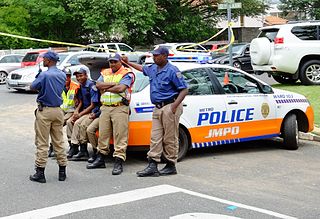
Transkei, officially the Republic of Transkei, was an unrecognised state in the southeastern region of South Africa from 1976 to 1994. It was, along with Ciskei, a Bantustan for the Xhosa people, and operated as a nominally independent parliamentary democracy. Its capital was Umtata.

A Bantustan was a territory that the National Party administration of South Africa set aside for black inhabitants of South Africa and South West Africa, as a part of its policy of apartheid.

Hendrik Frensch Verwoerd, also known as H. F. Verwoerd, was a Dutch-born South African politician, scholar, and newspaper editor who was Prime Minister of South Africa and is commonly regarded as the architect of apartheid and nicknamed the "father of apartheid". Verwoerd played a significant role in socially engineering apartheid, the country's system of institutionalized racial segregation and white supremacy, and implementing its policies, as Minister of Native Affairs (1950–1958) and then as prime minister (1958–1966). Furthermore, Verwoerd played a vital role in helping the far-right National Party come to power in 1948, serving as their political strategist and propagandist, becoming party leader upon his premiership. He was the Union of South Africa's last prime minister, from 1958 to 1961, when he proclaimed the founding of the Republic of South Africa, remaining its prime minister until his assassination in 1966.

Pieter Willem Botha, was a South African politician. He was the head of government of South Africa from 1978 to 1989, serving as the last prime minister of South Africa from 1978 to 1984 and the first executive state president of South Africa from 1984 to 1989.

Ciskei, officially the Republic of Ciskei, was a Bantustan for the Xhosa people, located in the southeast of South Africa. It covered an area of 7,700 square kilometres (3,000 sq mi), almost entirely surrounded by what was then the Cape Province, and possessed a small coastline along the shore of the Indian Ocean.

The National Party, also known as the Nationalist Party, were a political party in South Africa from 1914 to 1997, which was responsible for the implementation of apartheid rule. The party was an Afrikaner ethnic nationalist party, which initially promoted the interests of Afrikaners but later became a stalwart promoter and enactor of white supremacy, for which it is best known. It first became the governing party of the country in 1924. It merged with its rival, the SAP, during the Great Depression, and a splinter faction became the official opposition during World War II and returned to power. With the National Party governing South Africa from 4 June 1948 until 9 May 1994, the country for the bulk of this time was only a de jure or partial democracy, as from 1958 onwards non-white people were barred from voting. In 1990, it began to style itself as simply a South African civic nationalist party, and after the fall of apartheid in 1994, attempted to become a moderate conservative one. The party's reputation was damaged irreparably by perpetrating apartheid, and it rebranded itself as the New National Party in 1997 before eventually dissolving in 2005.

The Bantu Education Act 1953 was a South African segregation law that legislated for several aspects of the apartheid system. Its major provision enforced racially-separated educational facilities; Even universities were made "tribal", and all but three missionary schools chose to close down when the government would no longer help to support their schools. Very few authorities continued using their own finances to support education for native Africans. In 1959, that type of education was extended to "non-white" universities and colleges with the Extension of University Education Act, 1959, and the University College of Fort Hare was taken over by the government and degraded to being part of the Bantu education system. It is often argued that the policy of Bantu (African) education was aimed to direct black or non-white youth to the unskilled labour market although Hendrik Verwoerd, the Minister of Native Affairs, claimed that the aim was to solve South Africa's "ethnic problems" by creating complementary economic and political units for different ethnic groups. A particular fear of the National Party that most likely led to the passing of this legislation was the rising number of children joining urban gangs.

Kavangoland was a bantustan and then later a non-geographic ethnic-based second-tier authority, the Representative Authority of the Kavangos, in South West Africa, intended by the apartheid government to be a self-governing homeland for the Kavango people.

Apartheid was a system of institutionalised racial segregation that existed in South Africa and South West Africa from 1948 to the early 1990s. Apartheid was characterised by an authoritarian political culture based on baasskap, which ensured that South Africa was dominated politically, socially, and economically by the nation's minority white population. In this minoritarian system, there was social stratification and campaigns of marginalization such that white citizens had the highest status, with them being followed by Indians as well as Coloureds and then Black Africans. The economic legacy and social effects of apartheid continue to the present day, particularly inequality.

The Natives Land Act, 1913 was an Act of the Parliament of South Africa that was aimed at regulating the acquisition of land. It largely prohibited the sale of land from whites to blacks and vice-versa.

The Promotion of Bantu Self-Government Act, 1959 was an important piece of South African apartheid legislation that allowed for the transformation of traditional tribal lands into "fully fledged independent states Bantustans", which would supposedly provide for the right to self-determination of the country's black population. It also resulted in the abolition of parliamentary representation for black South Africans, an act furthered in 1970 with the passage of the Black Homeland Citizenship Act.

The system of racial segregation and oppression in South Africa known as apartheid was implemented and enforced by many acts and other laws. This legislation served to institutionalize racial discrimination and the dominance by white people over people of other races. While the bulk of this legislation was enacted after the election of the National Party government in 1948, it was preceded by discriminatory legislation enacted under earlier British and Afrikaner governments. Apartheid is distinguished from segregation in other countries by the systematic way in which it was formalized in law.

Law enforcement in South Africa is primarily the responsibility of the South African Police Service (SAPS), South Africa's national police force. SAPS is responsible for investigating crime and security throughout the country. The "national police force is crucial for the safety of South Africa's citizens" and was established in accordance with the provisions of Section 205 of the Constitution of South Africa.
South African citizenship has been influenced primarily by the racial dynamics that have structured South African society throughout its development. The country's colonial history led to the immigration of different racial and ethnic groups into one shared area. Power dispersion and inter-group relations led to European dominance of the state, allowing it to directly shape citizenship although not without internal division or influence from the less empowered races.

The Bantu Authorities Act, 1951 was to give authority to Traditional Tribal Leader within their traditional tribal homelands in South Africa. It also gave the government extensive powers to proclaim these chiefs and councillors, despite the backlash it may receive. This legislation, succeeding the Native Affairs Act, created the legal basis for Self Determination of the various ethnic and linguistic tribes into traditional homeland reserve areas and established tribal, regional and territorial authorities. This Act was augmented by the Bantu Homelands Citizens Act of 1970.

The Bantu Investment Corporation Act, Act No 34 of 1959, formed part of the apartheid system of racial segregation in South Africa. In combination with the Bantu Homelands Development Act of 1965, it allowed the South African government to capitalize on entrepreneurs operating in the Bantustans. It created a Development Corporation in each of the Bantustans.

The Native Trust and Land Act, 1936 in South Africa passed a law that served as the reorganization of its agricultural structures. This followed the recommendations of the Beaumont Commission.

Kabokweni is a town in Ehlanzeni District Municipality in the Mpumalanga province of South Africa. Kabokweni was formally established in 1967 as the first residential township in the KaNgwane Bantustan. In 1968 the Bantu Affairs Department of the Apartheid state forcibly moved over 3000 people from the town of White River to Kabokweni. Today, it is a town of over 20 000 people.
Werner Willi Max Eiselen (1899–1977) was a South African anthropologist and linguist fluent in a number of African languages. He was an ally and associate of Hendrik Verwoerd, the Minister of Native Affairs from 1950 to 1958 and the Prime Minister of South Africa from 1958 to 1966. He led the Eiselen Commission, an advisory board that investigated native education and formed the basis of the Bantu Education Act of 1953 which moved control of education of South Africa's blacks from missionary schools to local government control. It also made starting a "Bantu" school without permission and registration from the government illegal.












